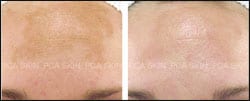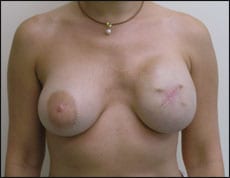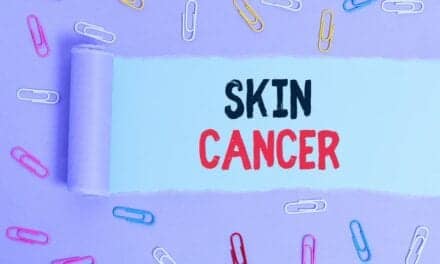| Before | After |
 |
|
| Condition: Melasma Solution: twice daily care: facial wash (pHaze 1); Brightening Therapy with TrueTone; protecting hydrator SPF 25 (pHaze 7); ReBalance (pHaze 17); Professional treatment (three): PCA Peel® with hydroquinone. |
|
Hyperpigmentation is a common, harmless skin condition in which patches of skin become darker in color than the surrounding skin. Most, but not all, hyperpigmentation cases are due to an excess of melanin that forms deposits in the skin. Hyperpigmentation can affect people of all races.
Topical agents commonly used to treat hyperpigmentation disorders include phenols (hydroquinone and mequinol), retinoids (tretinoin), alpha-hydroxy acids (glycolic acid), salicylic acid, and azelaic acid. However, according to dermatologists, combination therapy offers the best results.
One product, Brightening Therapy with TrueTone, by PCA Skin, Scottsdale, Ariz, combines alpha-arbutin, a natural beta-D-glucopyranoside derivative of hydroquinone that allows controlled release of HQ. Arbutin inhibits the activity of tyrosinase and melanosome maturation. The second melanogenesis inhibitor is phenylethyl resorcinol, a derivative of the commonly used keratolytic, resorcinol. This ingredient is unique in that it inhibits the conversion of tyrosinase to L-DOPA, and prevents melanin production. Undecylenoyl phenylalanine inhibits the production of melanocyte-stimulating hormone.
Inhibiting this hormone prevents the production of tyrosinase and melanosomes and the deposit of pigment into the keratinocytes.
Brightening Therapy with TrueTone also contains a blend of anti-inflammatory, antioxidant, and MMPi ingredients that prevent the inflammatory stimuli that are responsible for causing and exacerbating hyperpigmentation.
“The brightening agents in TrueTone have been compared in in vitro testing to commonly utilized ingredients such as kojic acid and hydroquinone, and have shown comparable results with no irritation,” says Jennifer Linder, MD, dermatologist, Mohs skin cancer surgeon, and chief scientific officer at PCA Skin. “While many products on the market are effective, traditional ingredients used can be irritating to certain skin types and colors, and can ultimately lead to additional discolorations. The results of this product are comparable, and in some cases more dramatic, than similar products available, but without the risk of causing further problems by inducing irritation.”
According to Linder, as with all hyperpigmentation regimens, treatment time varies depending on the type and depth of the pigment and on patient compliance. Patients begin to see a more even skin tone within weeks of beginning treatment, and many will see dramatic results within 12 weeks of use.
Brightening Therapy with TrueTone may be used alone or in conjunction with other products designed to reduce hyperpigmentation.
 |
Book Review
According to research conducted at Dartmouth Medical School, Hanover, NH, the number of melanomas being diagnosed is on the rise, with a 4% to 6% increase per year. However, whether this is a fact or fiction is a matter of opinion.
In his book, The Sun and the “Epidemic” of Melanoma: Myth on Myth!, A. Bernard Ackerman, MD, emeritus director of the Ackerman Academy of Dermatopathology in New York, presents the pros and cons of issues related to the sun and melanoma. Included in the book are the author’s “Conclusions Based on the Evidence,” which, collectively, dismiss the purported melanoma epidemic as a “myth.”
“I do not think the sun is responsible for melanoma; I think genes are responsible for melanoma,” says Ackerman, who calls the talk of a causal relationship between sun exposure and melanoma “malarkey.”
According to Ackerman, Asians and Africans develop melanoma only on palms, soles, nail units, and mucous membranes. In addition, he notes that the most common melanoma sites in Caucasians—women’s legs and men’s torsos—typically receive far less exposure to the sun than the face and arms. Black African albinos, exposed inordinately to sunlight, as they are daily, hardly ever develop melanoma, he says.
“All the epidemiologic data pertinent to sunlight and melanoma are flawed egregiously, among them being ‘migration studies,’ ‘differences by latitude of residence,’ and ones based wholly on anecdote subject to ‘recall bias,’ such as the ludicrous assertion that ‘a single blistering sunburn in childhood puts an individual at markedly increased risk for developing melanoma,’ ” Ackerman says. “Parenthetically, the charge that ‘there is no such thing as a safe tan’ is equally spurious.” n
Publisher: Ardor Scribendi Ltd
ISBN: 978-1-893357-36-5
Format: Paperback, 439 pages
Price: $50





